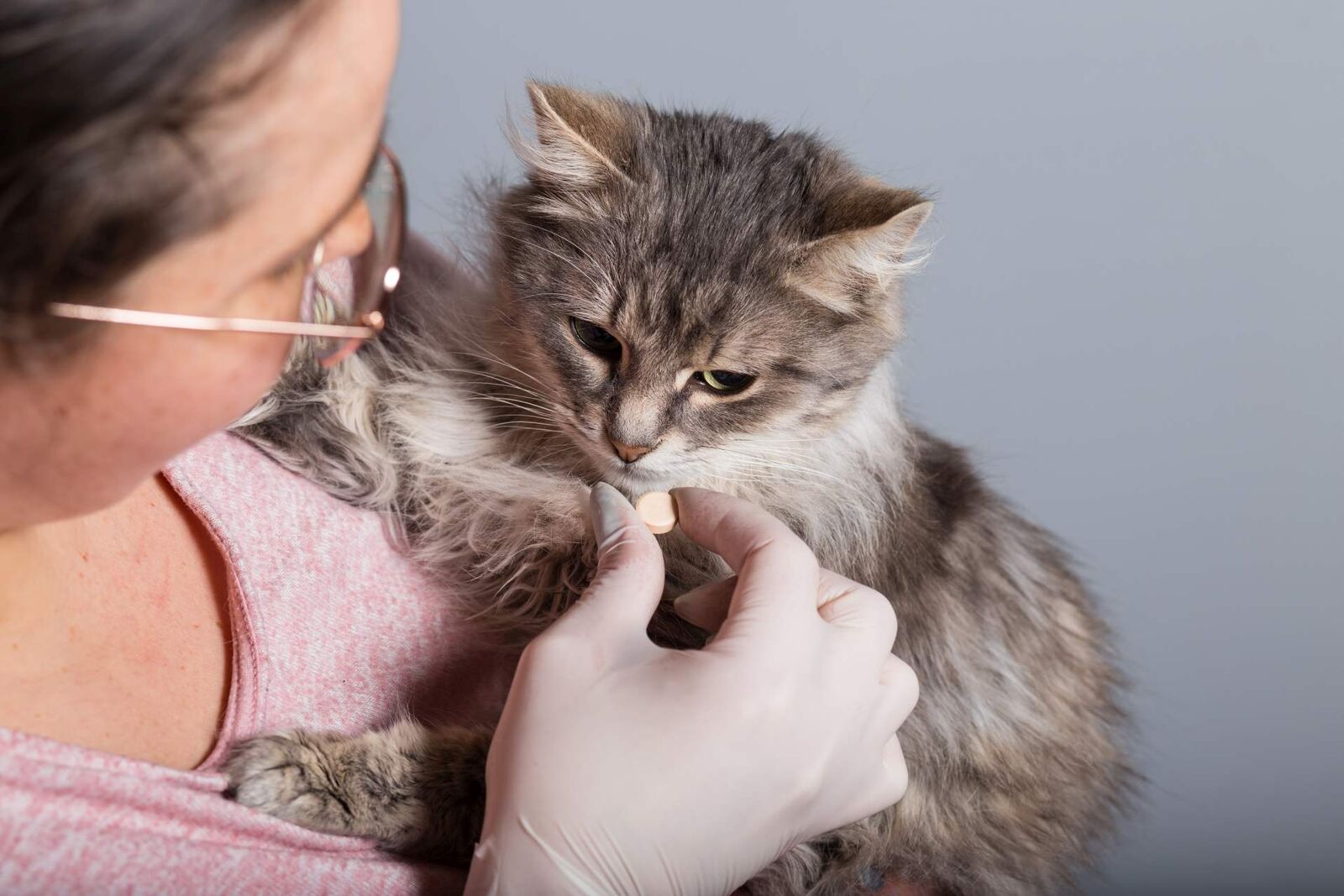You've sniffed the grass, rolled around on grass or had close contact with other cats - and it's happened: your cat has become infected with worms such as roundworms or tapeworms. This is not unusual and is not a problem for healthy animals - but it is still important to deworm your pet regularly. This is the only way to prevent a minor infestation from becoming a serious one. This guide will tell you how to recognize a worm infestation and how to deworm it. We'll also show you what products are available for deworming cats and how often you should use them.
How cats become infected with worms
An infection with worms can occur very quickly. If the cat sniffs the feces of an animal with worms, it may pick up worms or worm eggs with its snout. Eggs can also get caught in the fur when the cat rolls around on infected grass . The next time the cat grooms itself, these get into the gastrointestinal tract, where they can spread. The same applies to eating animals with worms. Mice and other rodents in particular are often infected with worms. If the cat eats these, the worms also reach its digestive tract.
Fleas are another risk of infection. They are often intermediate hosts for worms and most commonly transmit the cucumber seed tapeworm . For this reason, it is also necessary to check your cat for fleas and treat the infestation.
It is not only outdoor cats that suffer from worm infestations, although they are at a much higher risk because they have many more points of contact with the worms outside. Indoor cats can also become infected with worms. If your shoes have touched a worm-infested floor, the worms can stick to your soles . If the dirt is then brought into the house, there is a chance that the cat will ingest the worms or worm eggs.
If a cat in the household is infected with worms and a second cat uses the same litter box, there is also a risk of infection. Setting up several litter boxes and cleaning them regularly can make a big difference and prevent infections.
[Aufbaukur+Sensitive]
How do you detect a worm infestation?
If the worm infestation is minor, the cat will hardly suffer from any symptoms . The infestation usually goes undetected. It is good that the animal is not in any pain or discomfort. However, this also means that the worms can continue to spread undisturbed.
If the cat's immune system is not strong enough, it will react to the infestation with diarrhea or vomiting , for example. Dull fur and weight loss are also signs of worms. The worms themselves are also signs of an infestation: they are sometimes excreted in the feces and are recognizable as thin white threads . The worms can also appear in vomit.
If your pet is well and does not show any symptoms, you should still check its stool regularly. Even if the animal does not have diarrhea, worms can be excreted. If you suspect that your animal is suffering from worms, have one or more stool samples examined by the vet.
If your cat is suffering from symptoms such as diarrhea, vomiting or even weight loss due to the worm infestation, it is advisable to adjust the diet accordingly . Make sure that the food is gentle on the stomach . After deworming, a weight-loss treatment is recommended to help your pet get back to its normal weight.
Treating your cat with worms
Deworming is the most effective way to rid your cat of parasites. Deworming is a medication that kills the worms in the cat's body. However, you should always consult your vet before giving your cat a deworming treatment.
How is the worming treatment administered?
The easiest way to give your pet a worming treatment is with a spot-on preparation . You simply drip this onto the back of your cat's neck. The product is then absorbed by the skin and enters the cat's body, where it acts against the parasites and also kills the worm eggs. This also prevents excreted worms from reaching other animals or people. The amount of spot-on to be administered usually depends on the cat's body weight .
In addition to administering spot-on medication, you can also deworm your cat using tablets or pastes . However, since animals are very sensitive to oral medication, spot-on is the most popular method of deworming. If your cat does not want to take tablets or pastes, do not force it to do so. This causes a lot of stress for the animal. In this case, consult your doctor to see whether a spot-on medication can also be administered.
In order to carry out the most effective treatment possible, it is advisable to use a combination preparation . This combats various types of worms such as hookworms, tapeworms and roundworms. It is often also advisable to choose a preparation that also works against ticks and fleas in addition to worms.
If the worming treatment is effective, the cat may still excrete worms through very soft stools. In this case, however, the worms die and the body expels them from the organism.
However, treatment with a worming treatment is not prophylactic . The preparation only works for 24 to 72 hours after administration and during this time kills the worms and eggs in the cat's body. If your house cat comes into contact with worms again after this time, it can become infected again. In order to prevent the spread, serious infestation and the development of worm eggs, it is therefore even more important to deworm the cat regularly .
How often should you deworm your cat?
When it comes to the frequency of deworming, a distinction should be made between outdoor cats and indoor cats. Since outdoor cats are at a higher risk of becoming infected with worms, they should also be dewormed more regularly . A quarterly cycle is recommended. This way, any worms in the cat's body have no chance to spread too much.
Indoor cats should be dewormed at least once a year . If you do not want to deworm your cat, you can also have the animal's feces regularly tested for worms. However, a single sample is usually not informative enough, as it may be that there are no worms in this sample. If you decide to have a worm test , it is best to collect feces on three consecutive days and give them to the vet for examination. This collective sample provides more reliable information about the actual worm infestation.
While healthy cats should be dewormed one to four times a year, depending on how much time they spend outside, this is often not enough for animals with a weak immune system . Kittens are dewormed for the first time in the fourth week of life , and then they should be dewormed every two weeks . Only when they have lived away from their mother for at least two weeks can the treatment be adjusted to a more frequent schedule. Special treatment also applies to nursing cats . Regardless of whether they are outdoor cats or indoor cats, the mother should be dewormed immediately after her kittens have been treated . This way the mother and kittens cannot infect each other.
If your animal is suffering from an immune deficiency due to an illness , it is also advisable to deworm it more frequently . This way you avoid the worms putting additional strain on the weakened immune system. In this case, even a mild worm infestation could lead to more severe symptoms. The same applies to vaccinations . Since a worm infestation further weakens the immune system, the vaccination may not work properly. So if a vaccination is imminent, deworm your cat beforehand.
For animals with a severe worm infestation , it is advisable to administer a second worming treatment four weeks after the first . If worms or eggs survive the first treatment, they will be killed with the second treatment. A new stool sample can also provide clarity about the success of the treatment.
The frequency of deworming your cat does not only depend on the condition of your cat. The condition of the people in the household is also crucial. If there are babies, small children or people with weak immune systems in the household, you should consult your veterinarian to see whether more frequent deworming of the cat is advisable to protect the residents. Worms are not specifically aimed at cats, and transmission to humans is also possible under certain circumstances.
How can you reduce the risk of worm infestation?
If possible, pay particular attention to the stool of an outdoor cat. As soon as you discover or suspect a worm infestation, you can act early. While you have little control over what your cat rolls around in or sniffs when it goes outside, you can at least influence what it eats .
It is best not to feed your cat raw meat . If you BARF your animal, i.e. feed it species-appropriate raw food, freeze the raw meat beforehand at at least -17 °C to -20 °C . This kills parasites such as worms . Also make sure that the cold chain is maintained when purchasing the meat and that it is high quality meat .
In addition to diet, contact with other cats is also a key factor in infection. If an animal is affected by worms and comes into contact with your cat, there is a possibility of transmission. So pay attention to whether your cat comes into contact with neighbors' cats when it goes outside. In this case, there is an increased risk of infestation.
But it's not just the neighbor's cat that can transmit the disease. If you have several cats at home, there's a risk of transmission. Toilets in particular are an absolute hotspot for worm infections. So make sure that the toilet is very hygienic and that you clean the litter box regularly. If you have several cats, it's generally advisable to set up several litter boxes .









